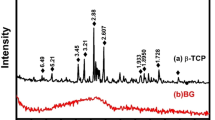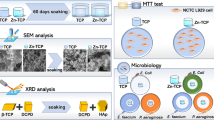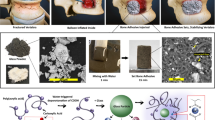Abstract
In this work, three commercial PMMA-based bone cements (high, medium and low viscosities) were enriched with a bioactive and Ag-containing glass to contemporaneously impart bioactive and antibacterial properties. For each formulation, the glass distribution in the polymeric matrix, the bioactivity in simulated body fluid, the silver release, the antibacterial effect and cytotoxicity were evaluated. Morphological and compositional characterizations, by means of scanning electron microscopy and energy-dispersive spectrometry, evidenced good glass dispersion in the polymeric matrix and its appreciable exposition on material surface for all composite cements. The different formulations did not entail the composite ability to induce hydroxyapatite precipitation on their surface (bioactivity) and to release silver ions. The silver release profile was comparable with the rate of infection development; moreover, antibacterial test (inhibition halo evaluation and count of colonies forming units) revealed a significant antibacterial effect towards S. aureus strain. Finally, cytotoxicity test, performed using continuous mouse fibroblast L-929, showed none cytotoxic effect of the multifunctional composite cements for all the polymeric matrix formulations.








Similar content being viewed by others
References
Diefenbeck M, Mückley T, Hofmann GO (2006) Prophylaxis and treatment of implant-related infections by local application of antibiotics. Injury Int J Care Injured 37:S95–S104. doi:10.1016/j.injury.2006.04.015
Uçkay I, Hoffmeyer P, Lew D, Pittet D (2013) Prevention of surgical site infections in orthopaedic surgery and bone trauma: state-of-the-art update. J Hosp Infect 84(1):5–12. doi:10.1016/j.jhin.2012.12.014
Kurtz SM, Ong KL, Schmier J, Mowat F, Saleh K, Dybvik E, Kärrholm J, Garellick G, Havelin LI, Furnes O, Malchau H, Lau E (2007) Future clinical and economic impact of revision total hip and knee arthroplasty. J Bone Joint Surg Am 89(Suppl 3):144–151. doi:10.2106/JBJS.G.00587
Phillips JE, Crane TP, Noy M, Elliott TS, Grimer RJ (2006) The incidence of deep prosthetic infections in a specialist orthopaedic hospital: a 15-year prospective survey. J Bone Joint Surg Br 88(7):943–948. doi:10.1302/0301-620X.88B7.17150
Anagnostou F, Debet A, Pavon-Djavid G, Goudaby Z, Hélary G, Migonne V (2006) Osteoblast functions on functionalized PMMA-based polymers exhibiting Staphylococcus aureus adhesion inhibition. Biomaterials 27:3912–3919. doi:10.1016/j.biomaterials.2006.03.004
Breusch SJ, Aldinger PR, Thomsen M, Ewerbeck V, Lukoschek M (2000) Anchoring principles in hip endoprostheses. I: prosthesis stem. Unfallchirurg 103:918–931
Mousa WF, Kobayashi M, Shinzato S, Kamimura M, Neo M, Yoshihara S, Nakamura T (2000) Biological and mechanical properties of PMMA-based bioactive bone cements. Biomaterials 21:2137–2146. doi:10.1016/S0142-9612(00)00097-1
Hennig W, Blencke BA, BroKmer H, Deutscher KK, Gross A, Ege W (1979) Investigations with bioactivated polymethylmethacrylate. J Biomed Mater Res 13:89–99. doi:10.1002/jbm.820130110
Heikkila JT, Aho AJ, Kangasniemi I, Yli-Urpo A (1996) Polymethylmethacrylate composites: disturbed bone formation at the surface of bioactive glass and hydroxyapatite. Biomaterials 17:1755–1760
Serbetci K, Korkusuz F, Hasirci N (2004) Thermal and mechanical properties of hydroxyapatite impregnated acrylic bone cements. Polym Testing 23:145–155. doi:10.1016/S0142-9418(03)00073-4
Matthew W, Squire MD, Brian J, Ludwig MD, Jonathan R, Thompson BS, Jagodzinski BSJ, Hall BSD, Andes MDD (2008) Premixed antibiotic bone cement an in vitro comparison of antimicrobial efficacy. J Arthroplasty 23(6):110–114. doi:10.1016/j.arth.2008.03.014
Bistolfi A, Massazza G, Verné E, Massè A, Deledda D, Ferraris S, Miola M, Galetto F, Crova M (2011) Antibiotic-loaded cement in orthopedic surgery: a review. ISRN Orthop 2011:1–8
Bertazzoni Minelli E, Della Bora T, Benini A (2011) Different microbial biofilm formation on polymethylmethacrylate (PMMA) bone cement loaded with gentamicin and vancomycin. Anaerobe 17(6):380–383. doi:10.1016/j.anaerobe.2011.03.013
http://www.tecres.it/products_dett.php?lang=en&cat=ortopedia&id_cat=29&id_prod=48
Thornes B, Murray P, Bouchier-Hayes D (2002) Development of resistant strains of Staphylococcus epidermidis on gentamicin-loaded bone cement in vivo. J Bone Joint Surg 84:758–760
Campoccia D, Montanaro L, Speziale P, Arciola CR (2010) Antibiotic-loaded biomaterials and the risks for the spread of antibiotic resistance following their prophylactic and therapeutic clinical use. Biomaterials 31:6363–6377. doi:10.1016/j.biomaterials.2010.05.005
Alt V, Bechert T, Steinrucke P, Wagener M, Seidel P, Dingeldein E, Domann E, Schnettler R (2004) An in vitro assessment of the antibacterial properties and cytotoxicity of nanoparticulate silver bone cement. Biomaterials 25:4383–4391. doi:10.1016/j.biomaterials.2003.10.078
Prokopovich P, Leech R, Carmalt CJ, Parkin IP, Perni S (2013) A novel bone cement impregnated with silver–tiopronin nanoparticles: its antimicrobial, cytotoxic, and mechanical properties. Int J Nanomed 8:2227–2237. doi:10.2147/IJN.S42822
Feng QL, Wu J, Chen GQ, Cui FZ, Kim TN, Kim JO (2000) A mechanistic study of the antibacterial effect of silver ions on Escherichia coli and Staphylococcus aureus. J Biomed Mater Res 52(4):662–668
Kim JS, Kuk E, Yu KN, Kim JH, Park SJ, Lee HJ, Kim SH, Park YK, Park YH, Hwang CY, Kim YK, Lee YS, Jeong DH, Cho MH (2007) Antimicrobial effects of silver nanoparticles. Nanomedicine 3(1):95–101. doi:10.1016/j.nano.2006.12.001
Moojen DJ, Vogely HC, Fleer A, Verbout AJ, Castelein RM, Dhert WJ (2009) No efficacy of silver bone cement in the prevention of methicillin-sensitive Staphylococcal infections in a rabbit contaminated implant bed model. J Orthop Res 27(8):1002–1007. doi:10.1002/jor.20854
Arcos D, Ragel CV, Vallet-Regi M (2001) Bioactivity in glass/PMMA composites used as drug delivery system. Biomaterials 22:701–708. doi:10.1016/S0142-9612(00)00233-7
Cavalu S, Simon V, Goller G, Akin I (2011) Bioactivity and antimicrobial properties of PMMA/Ag2O acrylic bone cement collagen coated. Digest J Nanomater Biostruct 6(2):779–790
Verne’ E, Miola M, Ferraris S, Masse’ A, Bistolfi A, Crova M and Maina G Composite bone cements with a PMMA matrix, containing bioactive antibacterial glasses or glass-ceramics. Patent Specification EP2451493A2, WO2011004355A2, WO2011004355A3
Miola M, Bruno M, Maina G, Fucale G, Lucchetta G, Vernè E (2014) Antibiotic-free composite bone cements with antibacterial and bioactive properties. A preliminary study. Mater Sci Eng C 43:65–75. doi:10.1016/j.msec.2014.06.026
Miola M, Fucale G, Maina G, Verné E (2015) Antibacterial and bioactive composite bone cements containing surface silver-doped glass particles. Biomed Mater 10(5):055014. doi:10.1088/1748-6041/10/5/055014
Gerhardt LC, Boccaccini AR (2010) Bioactive glass and glass-ceramic scaffolds for bone tissue engineering. Materials 3:3867–3910. doi:10.3390/ma3073867
Hench LL (1993) Bioceramics. J Am Ceram Soc 81:705–728
Cao W, Hench LL (1996) Bioactive materials. Ceram Int 22:493–507. doi:10.1016/0272-8842(95)00126-3
Catauro M, Raucci MG, de Gaetano F, Marotta A (2004) Antibacterial and bioactive silver-containing Na2O·CaO·2SiO2 glass prepared by sol–gel method. J Mater Sci Mater Med 15:831–837
Verne’ E, Miola M, Vitale-Brovarone C, Cannas M, Gatti S, Fucale G, Maina G, Masse’ A, Di Nunzio S (2009) Surface silver-doping of biocompatible glass to induce antibacterial properties. Part I: massive glass. J Mater Sci Mater Med 20:733–740. doi:10.1007/s10856-008-3618-8
Miola M, Ferraris S, Di Nunzio S, Robotti PF, Bianchi G, Fucale G, Maina G, Cannas M, Gatti S, Masse’ A, Vitale-Brovarone C, Verne’ E (2009) Surface silver-doping of biocompatible glasses to induce antibacterial properties. Part II: plasma sprayed glass-coatings. J Mater Sci Mater Med 20(3):741–749. doi:10.1007/s10856-008-3618-8
Kokubo T, Takadama H (2006) How useful is SBF in predicting in vivo bone bioactivity? Biomaterials 27:2907–2915. doi:10.1016/j.biomaterials.2006.01.017
Performance standards for antimicrobial disk susceptibility tests, approved standard M2-A9, 9th edn. NCCLS, Villanova, PA, USA, 2003
Vitale-Brovarone C, Miola M, Balagna C, Vernè E (2008) 3D-glass–ceramic scaffolds with antibacterial properties for bone grafting. Chem Eng J 137:129–136. doi:10.1016/j.cej.2007.07.083
Jung WK, Koo HC, Kim KW, Shin S, Kim SH, Park YH (2008) Antibacterial activity and mechanism of action of the silver ion in Staphylococcus aureus and Escherichia coli. Appl Environ Microbiol 74(7):2171–2178. doi:10.1128/AEM.02001-07
Methods for Dilution Antimicrobial Susceptibility Tests for Bacteria That Grow Aerobically, Approved Standard M7-A6, 6th edn. NCCLS, Villanova, PA, USA, 2003
Vernè E, Ferraris S, Miola M, Fucale G, Maina G, Robotti P, Bianchi G, Martinasso G, Canuto RA, Vitale-Brovarone C (2008) Synthesis and characterisation of bioactive and antibacterial glass-ceramic Part 2–plasma spray coatings on metallic substrates. Adv Appl Ceram 107(5):245–253. doi:10.1179/174367508X289488
Petersen PJ, Hal Jones C, Bradford PA (2007) In vitro antibacterial activities of tigecycline and comparative agents by time-kill kinetic studies in fresh Mueller-Hinton Broth. Diagn Microbiol Infect Dis 59:347–349. doi:10.1016/j.diagmicrobio.2007.05.013
Subbiahdoss G, Kuijer R, Grijpma DW, van der Mei HC, Busscher HJ (2009) Microbial biofilm growth versus tissue integration: “The Race for the Surface” experimentally studied. Acta Biomater 5:1399–1404. doi:10.1016/j.actbio.2008.12.011
Vernè E, Ferraris S, Miola M, Fucale G, Maina G, Martinasso G, Ra Canuto, Di Nunzio S, Vitale Brovarone C (2008) Synthesis and characterization of a bioactive and antibacterial glass-ceramic (I): microstructure, properties and biological behavior. Adv Appl Ceram 107(5):234–244. doi:10.1179/174367508X306532
Kvitek L, Panacek A, Prucek R, Soukupova J, Vanickova M, Kolar M, Zboril R (2011) Antibacterial activity and toxicity of silver–nanosilver versus ionic silver. J Phys Conf Ser 304:1–8. doi:10.1088/1742-6596/304/1/012029
Luo SH, Xiao W, Wei XJ, Jia WT, Zhang CQ, Huang WH, Jin DX, Rahaman MN, Day DE (2010) In vitro evaluation of cytotoxicity of silver-containing borate bioactive glass. J Biomed Mater Res B Appl Biomater 95(2):441–448. doi:10.1002/jbm.b.31735
Acknowledgements
This work was partially financed, from 2010 to 2011, by BionicaTech s.r.l. (spinoff company of Politecnico di Torino).
Author information
Authors and Affiliations
Corresponding author
Rights and permissions
About this article
Cite this article
Miola, M., Fucale, G., Maina, G. et al. Composites bone cements with different viscosities loaded with a bioactive and antibacterial glass. J Mater Sci 52, 5133–5146 (2017). https://doi.org/10.1007/s10853-017-0750-1
Received:
Accepted:
Published:
Issue Date:
DOI: https://doi.org/10.1007/s10853-017-0750-1




